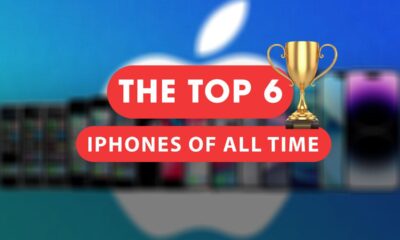Technology
Exploring the Future of Technology: A Comprehensive Guide to Global Tech Trends

Welcome to the exciting world of technology! In today’s fast-paced digital age, innovation is constantly transforming our lives. From smart homes and wearable tech to artificial intelligence and virtual reality, the possibilities seem endless. What lies ahead for the realm of technology? Join us on a journey as we explore the latest global tech trends and discover how they are shaping our world in ways we never imagined possible.
Introduction to Global Tech Trends
There is no doubt that technology is rapidly evolving. What was once considered cutting-edge is now commonplace, and new innovations are being developed every day. It can be difficult to keep up with all the latest advancements, but it’s important to be aware of the major global tech trends so you can stay ahead of the curve.
The Rise of Artificial Intelligence (AI)
In recent years, artificial intelligence (AI) has become one of the most widely discussed topics in the tech world. With major advances in machine learning and natural language processing, AI is beginning to have a significant impact on a wide range of industries.
AI is already being used for tasks such as identifying patterns in data, making predictions based on data, and automated decision-making. As AI technology continues to develop, its potential applications are becoming increasingly diverse. Some of the most exciting applications of AI that are currently being explored include:
Self-driving cars: AI can be used to create algorithms that enable vehicles to navigate without human input. This could potentially lead to a future where accidents are greatly reduced or even eliminated altogether.
Personalized medicine: AI can be used to analyze large amounts of data to identify patterns that could help doctors provide more personalized and effective treatment for their patients.
Cybersecurity: AI can be used to detect and prevent cyberattacks before they happen. This is particularly valuable in industries where sensitive data is often targeted by hackers, such as healthcare and finance.
These are just a few examples of the many ways in which AI is beginning to change the world as we know it. As AI technology continues to evolve, we can only imagine what other exciting innovations it will bring about in the years to come.
Virtual and Augmented Reality Technologies
Virtual reality (VR) and augmented reality (AR) are two of the most talked-about technologies today. And while they may seem like futuristic concepts, they’re already being used in a variety of industries, from gaming to healthcare.
So, what exactly are VR and AR? And what impact will they have on the future of technology?
What is Virtual Reality (VR)?
Virtual reality is a computer-generated simulation of an environment that can be experienced by a user through sensory input, such as sight, sound, and touch. A VR headset is worn by the user, immersing them in the virtual world.
What is Augmented Reality (AR)?
Augmented reality is similar to virtual reality, but instead of creating a completely artificial environment, it overlays digital information on the real world. This can be done with a head-mounted display or through a smartphone camera.
How are VR and AR Used Today?
VR and AR are being used in a number of industries, including gaming, healthcare, retail, education, and more. Here are some examples:
•In healthcare, VR is being used for medical training and to treat conditions like PTSD.
• In retail, AR is being used to provide customers with an immersive shopping experience.
For example, Ikea’s Place app lets users see how furniture looks in their home before they buy it.
•In the field of education, augmented reality (AR) and virtual reality (VR) are being utilized to develop immersive and interactive educational experiences. For example, Google Expeditions allows students to take virtual field trips around the world.
What’s the Future of VR and AR?
The future of VR and AR is exciting. We’re likely to see these technologies continue to be used for gaming, healthcare, retail, and more. Additionally, new applications will emerge as technological advancements make them more accessible and affordable. For example, we may soon see VR-enabled surgeries or AR-enabled factories. The possibilities are endless!
Robotics and Automation
Robotics and automation are two of the most exciting and rapidly growing fields in technology. From factory floors to hospitals, these technologies are increasingly being used to improve efficiency and productivity.
In the coming years, we can expect to see even more widespread adoption of robotics and automation. Presented below are several noteworthy trends to keep an eye on:
More collaborative robots: Traditional industrial robots have long been used in manufacturing settings, but they are now being increasingly adopted in other sectors such as healthcare, retail, logistics, and even agriculture. One of the key reasons for this is the development of more collaborative robots that can safely work alongside humans.
Increased use of artificial intelligence: Artificial intelligence is playing an increasingly important role in robotics and automation. By giving machines the ability to learn and make decisions on their own, AI is making them much more effective at carrying out tasks that would otherwise be difficult or impossible for humans to do.
Smarter factories: The combination of robotics, automation, and artificial intelligence is leading to the development of smarter factories that are able to operate with greater efficiency and flexibility than ever before. These factories are often referred to as Industry 4.0 facilities.
Improved safety: One of the key benefits of using robots is that they can help to improve safety in various settings by carrying out tasks that would be too dangerous for humans to do.
Blockchain Technology:
The blockchain is a distributed database that allows for secure, transparent and tamper-proof record-keeping. It is the underlying technology behind cryptocurrencies like Bitcoin and has the potential to disrupt a wide range of industries.
Despite its relatively young age, blockchain technology is already having a major impact on the world. Here are some examples of how it is being used:
Banking: The banking sector is one of the most likely to be disrupted by blockchain technology. Blockchain could allow for Peer-to-Peer (P2P) lending, help reduce fraudulent activities and make cross-border payments faster and more efficient.
Supply Chain Management: Blockchain can help to track the movement of goods and ensure that they are not counterfeit or stolen. This can help to improve efficiency and transparency in supply chains.
Healthcare: Blockchain has the potential to revolutionize healthcare by improving patient data security, reducing medical errors and making clinical trials more efficient.
These are just some of the ways in which blockchain technology is being used or could be used in the future. With its vast potential, it is likely that blockchain will continue to have a major impact on the world for years to come.
The Internet of Things (IoT)
The term “Internet of Things” (IoT) refers to the growing trend of interconnectedness between physical objects and devices and the internet. IoT devices can include anything from wearable technologies and smart appliances to connected cars and industrial machines. By 2020, it is estimated that there will be over 26 billion IoT devices in use worldwide.
IoT devices are able to collect and share data about their surroundings and user behavior. The data collected can enhance device usability or be analyzed to gain insights into trends and patterns. For instance, a fitness tracker captures information on activity, sleep, and diet to offer health recommendations. Similarly, IoT sensor data aids cities in understanding traffic patterns and facilitating infrastructure enhancements.
The potential applications of IoT are nearly limitless. In the near future, we can expect to see continued growth in the adoption of IoT devices and applications across all sectors of society.
Autonomous Vehicles
The future of transportation is autonomous. Self-driving cars are already being tested on public roads, and it’s not long before they’ll be available to consumers. But autonomous vehicles are just the beginning. In the future, we’ll see autonomous boats, planes, and trains. This technology will revolutionize transportation, making it safer, more efficient, and more environmentally friendly.
Cloud computing is a model that enables convenient and on-demand access to a shared pool of configurable computing resources, including networks, servers, storage, applications, and services. This technology allows users to access their data from anywhere and at any time.
The cloud computing model comprises five fundamental characteristics, three service models, and four deployment models.
Characteristics:
On-demand self-service: Users can provision computing capabilities, such as server time and network storage, automatically without requiring direct interaction with the service provider.
Broad network access: Capabilities are accessible over the network and can be used by diverse client platforms, such as mobile phones, laptops, and PDAs, through standard mechanisms.
Resource pooling: The provider’s computing resources are pooled to serve multiple consumers using a multi-tenant model. Physical and virtual resources are dynamically assigned and reassigned based on consumer demand. The customer typically has no control over the exact location of the resources but may specify a higher-level abstraction like country, state, or datacenter.
Rapid elasticity: Capabilities can be quickly scaled up or down to meet demand. Consumers perceive these capabilities as unlimited and can acquire them in any quantity at any time.
Measured service: Cloud systems optimize and monitor resource usage by leveraging metering capabilities. Resource utilization, such as storage, processing, bandwidth, and active user accounts, can be monitored, controlled, and reported, providing transparency for both the provider and consumer of the services.
Service models:
Software as a Service (SaaS) allows consumers to access provider applications running on a cloud infrastructure. These applications are accessible via different client devices, such as web browsers or program interfaces. Unlike traditional models, SaaS relieves consumers from managing the underlying cloud infrastructure, including networks, servers, operating systems, storage, and application capabilities. However, they retain control over the deployed applications and may have configuration options for the application-hosting environment.
Platform as a Service (PaaS) is a service model that enables consumers to deploy consumer-created or acquired applications using programming languages and tools provided by the cloud infrastructure provider. Consumers can develop, run, and manage applications without the need to handle the underlying infrastructure components. PaaS offers a platform for developers to build and deploy their applications with greater ease and efficiency.
Edge computing is a network architecture that processes data at the network’s edge, close to the data source. It aims to reduce latency and bandwidth usage by processing and analyzing data closer to where it is generated, rather than relying solely on centralized cloud infrastructure.
. Edge computing can be used to improve communication latency and reduce bandwidth consumption. It can also be used to improve security and privacy by processing data locally instead of sending it over the network.
5G Networks
The deployment of 5G networks is well underway, with major operators around the world launching commercial services. 5G promises a step change in mobile network performance, with much higher speeds and lower latency than 4G. This will enable a new generation of applications and services, including ultra-high definition video streaming, virtual reality and augmented reality, gaming, and the Internet of Things.
5G networks are based on a new radio technology known as OFDM (orthogonal frequency division multiplexing), which enables large amounts of data to be transmitted over wide bandwidths. The first 5G deployments are using frequencies in the millimeter wave band, which has very high capacity but limited range. In future, 5G will also make use of lower frequencies, which will provide better coverage but lower speeds.
One of the key benefits of 5G is that it will be much more energy efficient than previous generations of mobile networks. This is because OFDM transmits data using very short bursts of energy, rather than continuously like 4G. As a result, 5G networks will consume less power and generate less heat, making them more environmentally friendly.
In addition to faster speeds and lower latency, 5G will also support a much higher density of devices than 4G.
More connections to the network can be established simultaneously, ensuring uninterrupted service quality.
Although 5G network deployment is in its early stages, the potential of a new era of mobile connectivity is already being fulfilled. 5G will transform device usage and unlock a multitude of innovative applications and services, enhancing our connected lifestyles.
Conclusion
This guide has explored the various global technology trends that will continue to shape our world.
Emerging technologies like artificial intelligence, blockchain, and quantum computing are already reshaping our interactions with the world.
By gaining insights into upcoming trends, businesses can enhance their preparedness and maintain competitiveness in a dynamic market.
To keep pace with evolving technology, we must adapt our strategies to leverage the full potential of the latest advancements.

































